Brands reflect the identity of a company. The brand strategy needs to be carefully integrated with corporate image management. With multiple brands in a company, the problem is compounded. Each brand must reflect the company’s total image and differentiate itself from the rest of the brands in its portfolio. Hence, strategic brand management’s critical component of Brand Architecture requires a three-point focus – synergy, clarity, and leverage.
Unlock the Power of Brand Architecture! Elevate your brand strategy with our expert guidance. Discover the art of building lasting brand legacies today! Contact us NOW!
What is Brand Architecture?
The rise of brand architecture can be linked to the fact that traditional marketing machinery is worn out because of changing consumer values, intense competition, complex markets, numerous distribution channels, and the widening use of endorsed brands. Brands like Coca-Cola, Google, and Microsoft operate in diverse markets over multiple channels and product lines. This results in confusion, both for the marketers and the consumers. Well-defined brand architecture hence becomes imperative.
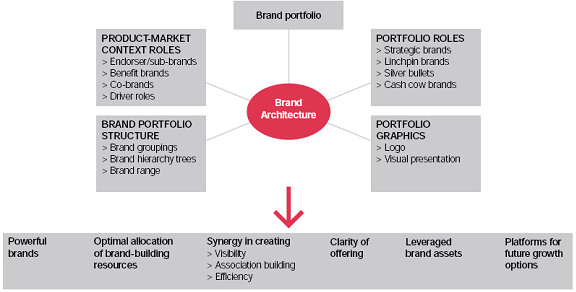
Brand Architecture Meaning
Brand architecture is the structure of brands within an organizational entity. It is the way in which the brands within a company’s portfolio are related to and differentiated from one another. The architecture should define the different leagues of branding within the organization; how the corporate brand and sub-brands relate to and support each other; and how the sub-brands reflect or reinforce the core purpose of the corporate brand to which they belong.
The elements of Brand architecture provide the blueprint for marketing decisions. Brand Architecture is the pictorial depiction of each relationship within and across the family of brands. Five dimensions define it – the brand portfolio, the roles of the portfolio brands, product-market context roles, the structure of the portfolio, and portfolio graphics.
A Brand architecture process is the unification of branding decisions and media. This provides a sound foundation for integrating all brands in a portfolio to synergize them into a powerful brand and identity.
The Best Branding Agency in India that will Build, Strengthen & Nurture Your Brand. Connect with us to develop a Brand Strategy to build a relevant & Differentiated Value Proposition that will deliver Business Results.
Brand Architecture Objectives
Creating power brands:
Strong brand offerings that synchronize with consumers’ logic and emotions, providing effective differentiation. For instance, Nestle distinguishes itself from the competition while simultaneously appealing to the masses.
Creating synergy:
Well-developed brand architecture provides for the synergy of brands, reinforcing associations, which in turn results in cost efficiencies. For instance, Gillette uses the common thread of providing “the best a man can get” in terms of quality and speed across all product categories.
Providing clarity in product offerings:
This is necessary to ensure a clear-cut identity among consumers.
Leveraging Brand Equity:
Make the brand work harder by increasing its impact. One way is through brand extensions that help to realize the complete value of the brand. A major function of the brand blueprint is to provide a strong framework to deal with brand extension opportunities (as the risks while extending are high).
Planning future growth:
Brand architecture strategy examples should plan for the brand’s future. It must be the foundation for making strategic advances in the marketplace.
Types of Brand Architecture Framework
There are three main types of brand architecture systems: monolithic, where the corporate name is used on all products and services offered by the company; endorsed, where all sub-brands are linked to the corporate brand by means of either a verbal or visual endorsement; and freestanding, where the corporate brand operates merely as a holding company, and each product or service is individually branded for its target market.
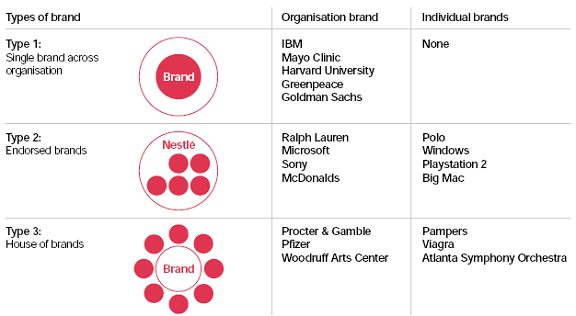
Monolithic brand or Branded House
Examples include Virgin Group, Red Cross, and Oxford University. These brands use a single name across all their activities, and this name is how they are known to all their stakeholders – consumers, employees, shareholders, partners, suppliers, and other parties.
Endorsed Brands
Endorsed brands Like Nestle’s KitKat, Sony PlayStation, or Polo by Ralph Lauren. The endorsement of a parent brand should add credibility to the endorsed brand in the eyes of consumers. This strategy also allows companies who operate in many categories to differentiate their different product groups’ positioning.
Freestanding brand or House of Brands
Freestanding brands or House of Brands Like Procter & Gamble’s Pampers or Henkel’s Persil. The individual sub-brands are offered to consumers, and the parent brand gets little or no prominence. Other stakeholders, like shareholders or partners, know the company by its parent brand.
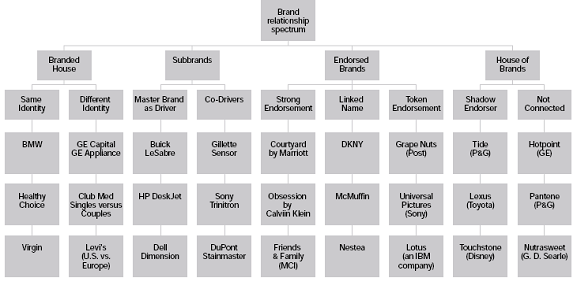
The Brand Portfolio Structure
The composition of a brand identity portfolio is imperative for the basic architectural parameter. Which brands to add or delete are major decisions to be taken. Building a brand requires adequate resources. If there are too many brands, there may not be enough resources to support them all. The task here is to choose and pick: Which brands will add value and which won’t? The brands that are not adding to the overall equity in any way need to be eliminated.
Multi-Brand Portfolio Roles
Brand Portfolios incorporate different brand roles that create synergy. This imparts a strategic perspective to the brands. Various roles include those of a strategic brand, linchpin brand, silver bullet brand, and cash cow brand. A brand could even be a combination of more than one.
Strategic Brand:
A brand that is projected to reap future sales and profits. It may be a laid-back brand that is headed towards becoming a major one. Leesures is a strategic brand for Lee’s as it lays the foundation for a position in casual wear in India.
Linchpin Brand:
A brand that holds the entire organisation together. It is a number one brand that indirectly influences a business area providing a strong base for customer loyalty. Cadbury’s Dairy Milk is a linchpin brand for Cadbury’s as it controls a critical segment in the confectionery industry.
Silver Bullet Brand:
A brand or sub-brand that positively influences the image of another brand. It can be a major factor in changing, creating or maintaining a brand image. HP’s laser jet resolution enhancement is a branded feature that instantly reflects on the image of HP being a breakthrough company in printer technology.
Cash Cow Brands:
Brands with significant customer bases that require less attention than other brands. The total sales may be on a decline, yet there are a group of hard-core loyal customers who do not leave the brand. The role of a cash cow brand is to generate resources that can be invested in other brands for future growth. Nivea Crème is one such example of a brand that has been extended to other skin-related products to provide resources for other brands by banking on its customer base.
Drivers of Brand Architecture:
- Firm-based characteristics
- Underlying market dynamics
- Product market characteristics and
- Nature and scope of the target market,
- The degree of market integration, and
- The cultural embeddedness of the product
Application of Brand Strategy Blueprint
1 International expansion:
With the globalization of markets and the growth of competition on a global scale, companies are increasingly expanding the geographic scope of their operations, setting up or acquiring companies in other countries, or entering into alliances across national boundaries. At the same time, markets are becoming more integrated with the spread of global and regional media, the development of international retailing, and the movement of people, goods, and organizations across national borders. As a result, firms need to pay greater attention to coordinating and integrating their marketing strategy across markets.
- Gap analysis: Determine market understanding of various parameters like consumer needs, competition/firm’s product range, and intermediary needs and plug the product in identified gaps.
A defined Brand Architecture helps a firm to establish its identity in the marketplace and develop a solid customer franchise, as well as providing a weapon to counter growing retailer power. They can also provide the basis for brand extensions, further strengthening the firm’s position and enhancing value (Aaker and Keller 1990).
Brand architecture helps answer the question of managing brands that span different geographic markets and product lines. Who should have custody of international brands and be responsible for coordinating their positioning in different national or regional markets, as well as making decisions about the use of a given brand name on other products or services?
2 Portfolio Management:
The biggest mistake is to allow each brand to be managed in isolation because what is right for an individual brand may be wrong for the portfolio in terms of:
- Too many brands in too many segments.
- There may be too many brands in relation to consumer needs, retailer space, and company ability to promote.
- Duplication and overlap.
- Gaps in priority market segments.
- Inefficiencies in operations and the supply chain.
- Diffused and, therefore, ineffective resource allocation.
Objective of Portfolio Management:
- Product drives customer satisfaction and revenue.
- It is essential to the demand generation process
- Translates market input into
- Innovation to market process
- Pruning the current product portfolio
- Helps to achieve the Goal of
- Most competitive product portfolio to meet end-user needs.
- Achieve optimal integral business results.
- Aligning acquired companies’ brands:
- The basis of brands to be invested in for future growth.
- The basis of brand selection for local or global promotion.
Portfolio Management Process:
- Prepare a comprehensive list of offers.
- Do margin analysis on each product SKU to determine profitability
Minimum Annual contribution Margin (CM%) per SKU = Cost of maintaining (COM%) a SKU in system
In case the CM% < COM% drop the product unless there is any other strategic reason.
- The strategic reasons to be considered:
- Long-term growth potential,
- Fighter strategy to gain market share, Complementary product line, and Impact on an important customer.
- Gap analysis: Determine market understanding of various parameters like consumer needs, competition/firm’s product range, and intermediary needs and identify products to plug these gaps.
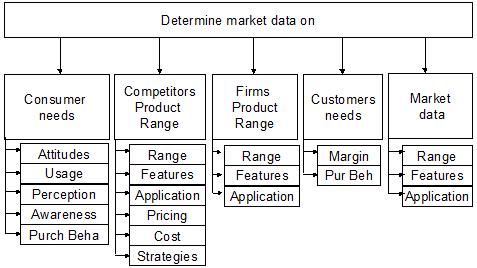
- Resegment the market: Resegment the market on various axis to identify the new product lines.
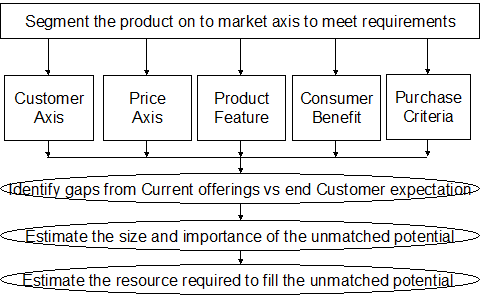
So the ideal portfolio:
- Fits the company’s future vision.
- Prioritise markets and key segments and efficiently covers those priority segments.
- Ruthlessly prunes out those that do not fit.
- Fills gaps through new or extended brands and acquisitions.
- Use consistent segment definitions across countries.
- Supports marketing strategy objective
- Brand positioning
- Meets target audience needs
- Align with the Innovation to market process
- Align with order fulfillment process
- Supports product account relation
- Generates profitability for the portfolio
Benefits of Portfolio Management
- Fewer non-performing items
- Reduce management cost
- Reduce maintenance cost
- Inventory carrying cost
- System maintenance cost
- Delivery cost
- Improve profitability
- New item introduction to meet consumers’ needs
- Helps to become more market responsive then competition
- Supports overall Brand Promise
Conclusion
In conclusion, brand architecture forms the cornerstone of a successful and enduring brand strategy. As a branding agency, we understand the significance of crafting a clear and purposeful brand structure that aligns with your business objectives and resonates with your target audience.
By defining the relationships between your brand’s sub-brands, products, and services, you can create a seamless and coherent brand experience. This strategic approach fosters brand recognition and empowers your organization to adapt and expand in a rapidly evolving marketplace.
Remember, a well-designed brand architecture is not a one-size-fits-all solution. It should be tailored to your unique brand identity and business goals. Investing in brand architecture empowers your brand to thrive and stand the test of time.
At BrandLoom, we are committed to helping you navigate the intricate world of brand architecture and unleash your brand’s true potential. Let’s collaborate to build a robust and influential brand foundation that sets you apart from the competition and leaves a lasting impression on your audience. Together, we can create a brand legacy that will endure and flourish in the ever-changing landscape of the business world.
Frequently Asked Questions
Why are brand architecture models important?
There are various reasons why a brand architecture template is crucial.
Clarity and Organization: Within a firm, brand architecture offers a distinct and well-organized framework for brands, goods, and services. It makes it simpler for consumers to explore and interact with the business by assisting them in understanding the connections between various brands and services.
Brand Consistency: A well-defined brand architecture guarantees consistency across all brand touchpoints. It provides standards for verbal and visual components such as logos, colors, and messages in order to preserve consistent brand identity and increase brand awareness.
Effective Brand Extension: Brand architecture makes creating brand extensions, sub-brands, and new goods easier. It offers a roadmap for how these new products fit into the entire brand portfolio, making sure they are consistent with the brand’s strategy, values, and target market.
Consumer Trust and Loyalty: A distinct brand architecture fosters consumer trust and loyalty. Customers feel more secure in their purchase selections. They are more likely to have a favorable opinion of the brand when they can quickly see and comprehend the connections between various brands and goods.
Resource Allocation: Brand architecture makes Effective resource allocation possible for businesses. Companies may make wise choices regarding marketing spending, product development, and brand investments by understanding the links and hierarchy between brands.What is brand portfolio meaning?
The strategic management of a company’s brand portfolio is called brand portfolio management. The definition of brand architecture entails making choices and putting plans into action to manage and maximize a company’s portfolio of brands efficiently. The aim of brand portfolio management is to maximize the total value and performance of the brand portfolio.
Important elements of managing a brand portfolio strategy examples include:
Brand Portfolio Analysis: This entails evaluating each brand’s market positioning, strengths, and limitations. It aids in identifying any gaps or overlaps in the brand portfolio restructuring as well as the function and potential of each brand.
Brand Architecture: Defining the structure and connections between the many brands within a portfolio is a part of brand portfolio management. The hierarchy, brand extensions, sub-brands, and co-branding tactics are all part of this.
Brand positioning: It entails figuring out each brand’s distinct stance and value proposition. Ensuring that each brand has a unique identity and target market prevents cannibalization and market confusion.
Resource Allocation: Brand portfolio management entails dividing up resources like marketing funds, R&D expenditures, and distribution channels across the portfolio’s brands. This guarantees that resources are distributed wisely to enhance the development and success of each brand.
Portfolio optimization: This entails selecting brands for acquisition, sale, or both, as well as rationalizing existing brands. By concentrating on brands with the greatest potential for development and selling off failing or non-strategic brands, it seeks to optimize the portfolio of brands.
Brand Performance Measurement: Monitoring and assessing each brand’s performance within the portfolio is a part of brand portfolio management. Key performance indicators (KPIs) include market share, brand equity, customer happiness, and financial metrics being tracked to achieve this.What are the four main brand architectures?
The following four categories of brand architecture:
Corporate Brand Architecture: In this form, the corporate brand serves as the principal brand and is used to promote all goods and services. Examples include Samsung, IBM, and Coca-Cola. This architecture uses the company brand’s equity and reputation to promote certain offers.
Branded house Architecture: This strategy, sometimes referred to as a monolithic or master brand architecture, uses a single brand for all goods and services. The creation of a powerful and cohesive brand identity is the main goal. FedEx, Virgin, and Google are a few examples. All offers are intimately linked to the master brand in this design.
House of Brands Architecture: In this architecture, the business runs a number of unique brands that are separate and unrelated to one another. Each brand is unique in terms of positioning, target market, and identity. Procter & Gamble, Unilever, and Nestlé are a few examples. The company’s portfolio is made up of a number of independent companies, each with its own marketing and branding plan.
Hybrid Brand Architecture: This design includes features from both branded homes and houses of brand architectures. Various corporate and individual brand names are used, with some goods or services being sold under corporate brands and others under individual brand names. Examples include General Electric (with brands like GE Appliances and GE Healthcare) and Marriott International (with brands like Marriott, Sheraton, and Ritz-Carlton).What are the benefits of a strong brand architecture?
The benefits of brand architecture examples are:
Clarity and Consistency: A well-defined brand architecture ensures that brands, goods, and services are structured and presented in a consistent manner. It makes it simpler for clients to explore and interact with the business by assisting them in understanding the connections between various services. Clarity and consistency help build consumer confidence in a brand.
Effective Brand Extension: Solid brand architecture makes creating brand extensions, sub-brands, and new goods possible. It offers a framework for how these products fit into the strong brand portfolio, ensuring that they complement the company’s positioning, values, and target market. This effectiveness in brand expansion reduces the amount of time and money needed to create and introduce new products.
Brand Differentiation: A well-structured brand architecture makes effective brand distinction possible. With the ability to target various client demographics and market niches, it helps businesses to develop unique identities and value propositions for each brand within the portfolio. This difference enables the business to stand out from rivals and win a bigger market share.
Customer Trust and Loyalty: A solid brand architecture fosters consumer trust and loyalty. Customers are more certain in their choices to buy when they can quickly recognize and comprehend the connections between various brands and items. Customer loyalty and happiness are also increased when a brand’s experience is consistent across all of its products.
Resource Allocation: Brand architecture aids in resource allocation for businesses. Companies may make wise choices regarding marketing spending, product development, and brand investments by understanding the links and hierarchy between brands. Optimizing each brand’s potential for development and profitability is possible by effectively allocating resources.What role does brand architecture strategy play in brand extensions?
The following are some essential functions of brand architecture in brand extensions:
Leveraging Brand Equity:
Brand architecture enables businesses to use an existing brand’s equity and reputation when launching new goods or services. Companies may profit from the current brand recognition, consumer loyalty, and favorable connotations associated with the parent brand by expanding the brand to new offers. This may hasten the market’s acceptance and adoption of the new product.
Brand Consistency:
Brand architecture makes sure that all brand extensions are consistent. To maintain a consistent brand identity, it offers rules for verbal and visual components, including messages, colors, and logos. Customers are more likely to identify and relate to a brand when it is consistent across all its products, increasing brand trust and loyalty.
Brand Association Transfer:
Brand architecture makes the transfer of favorable brand associations from the parent brand to the brand extension possible. Customers are more inclined to attach comparable good traits to the new item when they have a favorable opinion of the parent brand. This association transfer might assist clients in getting past any initial doubts they may have about a new item or service.
Differentiation and Positioning:
Brand architecture aids in brand differentiation and market positioning for businesses. It enables the development of unique identities and value propositions for each expansion, targeting certain client categories or market demands. The brand extension may stand out from rivals and build up a position for itself in the market thanks to this uniqueness.
Risk Reduction:
Brand architecture helps reduce the dangers of brand expansions. Companies may lower the perceived risk and uncertainty that consumers may have toward a new service by leveraging an existing brand. The safety net provided by the current brand equity and consumer trust increases the probability that the brand extension will be accepted and used.How do I determine the right brand architecture for my company?
Choosing the appropriate brand architecture for your business entails many crucial tasks, such as:
– Establish your company’s aims and objectives first, taking into account your target market, the competitors, and your long-term aspirations.
– Next, evaluate each brand’s advantages, disadvantages, and market positioning in your present portfolio.
– Identify your target market for each brand and get to know their wants and preferences.
– Analyze your sector’s competitive environment and market dynamics to spot possibilities and threats.
– Think about the connections you want between your brands and products, such as if you want a powerful corporate brand or a portfolio of distinct brands.
– To match your brand architecture with consumer expectations, get information about your target audience via research and feedback. Ensure your brand architecture is flexible and scalable to account for future growth and modifications.
– Consult with branding specialists or companies focusing on brand strategy if you need advice.
Consider every aspect carefully to ensure your chosen brand architecture supports your brand strategy and company objectives.







